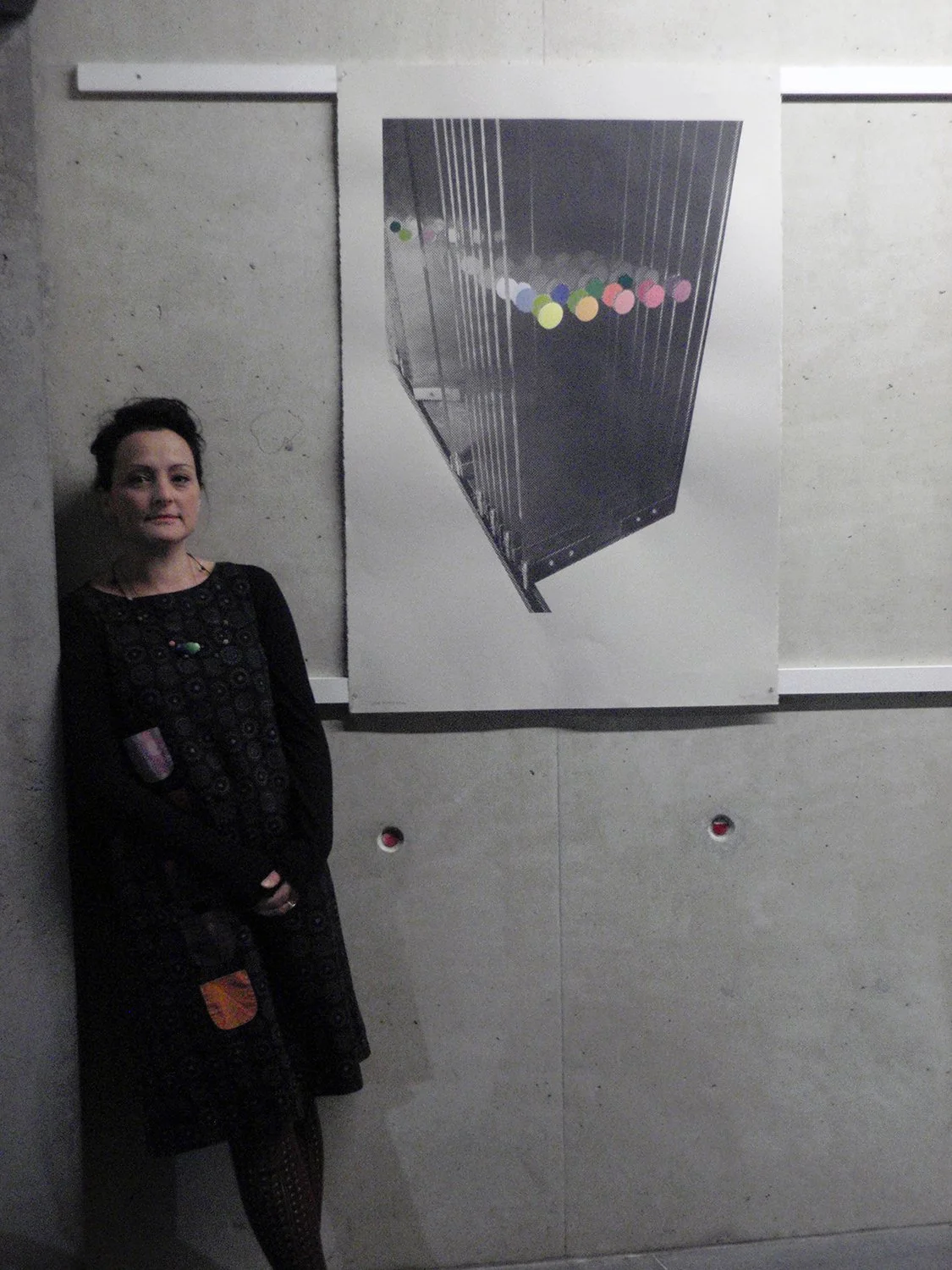Photography by Alex Lundy.
Saskia Haalebos
Saskia Haalebos is a neurodiverse, multidisciplinary artist who uses animation, coding, film, performance, printmaking, text—whatever the idea calls for around themes of time, mortality, empathy and mis/communication.
Her pinch me moments include the National Gallery of Australia asking her to create a family program for their building’s 40th birthday; being a guest artist for the EXTRA! EXTRA! residency as part of the Kaldor Public Art retrospective at the AGNSW; and having solo exhibitions at Goulburn Regional Art Gallery (NSW), Sawtooth ARI (TAS), Sydney Non Objective (NSW) and Megalo Print Studio and Gallery (ACT).
Her side hustle is working part time at the National Portrait Gallery, where she writes irreverent marketing copy and does a bunch of unglamorous admin.
She lives on unceded Ngunnawal Country in the beautiful ACT region of Australia.
Tell us about your creative process, what drives your practice?
Oh I’m a big daydreamer. I do a lot of staring into the distance and talking to myself (which can be hilarious when in public). If I’m out walking or on a bus, I tend not to fill my ears with music or podcasts – not that I don’t love these things – I just like to collaborate with my brain and let it surprise me. I also do a lot of automatic writing; that ‘not stopping to edit or see what’s come out until the chaos is over’ writing. Often it’s rubbish, but it does help to rummage through The Obvious and find the exciting swear-inducing ideas.
I majored in printmaking at the ANU School of Art & Design, but my practice is theme-based rather than print-based. I’m a big fan of experimentation too; and I like to cross over mediums to see what might happen. I’ve used hundreds of screenprints as animation frames, etched zinc plates into 45s to play on record players, and used computer coding to compose a soundscape on-the-fly.
Some might say it’s a folly not having a distinct style, ‘How will a commercial gallery sell your work?!’, but really, that’s not what I’m here for.
What is the role of chance and spontaneity within your practice and how do you embrace intuitive and responsive processes?
Oh I embrace it like a Nonna does her grandchildren! I think it’s important to just make without any idea of what you’re trying to do. That ‘giving over control to the process’ and letting ideas appear rather than trying to force them into something. When I have an upcoming exhibition and people ask me what I’m making, I usually say, ‘I don’t know yet! But *gestures with wiggling fingers to back of head* something’s happening; something will be on the walls!’ I trust that my subconscious is working it out, and once it has, then I’m very focussed on the making.
I’ve also made a few artworks that use chance as part of the medium. For example, And – a random poetry generator, which is a small box of iceblock sticks with words on them; News Room – a list of instructions for the audience to create a headline; and Terms of Endearment, which uses computer code to randomly choose three words from lists to create a very childish insult you can call your friend. Am I right, Squealing Tart Pants?
Most of your work navigates alternative forms of communication and language. How does this manifest within your multidisciplinary practice?
Words are not my first language. I can tell what a person is feeling by the slightest twitch in their face, but I often blurt out something totally inappropriate for a situation. Hello autism.
The focus on alternative forms of communication is to try and highlight the importance of empathy and how we can jump to conclusions from our own perspectives. For example, Threshold – five rows of black abstract shapes, which is actually a sentence if you can be bothered to decode and understand it; Score No. 0013 – a video projection of colours with recordings of my visceral response to each; and Field Notes, where I’ve been transcribing noises that are overheard, overlooked and aren’t speech.
I do love a word though. Say ‘Periphery’ and see how breathy that feels. Or ‘Ameliorate’ and notice how it tumbles out over your tongue. So magnificent.
Are there any female printmakers | artists that influence you?
Hands down, Alison Alder. If you don’t know who she is, what are you even doing with your life? Brilliant, humble, cheeky. Amongst a million other achievements in her life, she is currently the inaugural artist in residence at Parliament House. She was also my Honours supervisor and I am definitely a better human for having known her.
Also, Yoko Ono. Her, Grapefruit: a book of instructions and drawings, from 1964 is something I’d grab in a fire.
And ‘cause I love a list, here’s this for you to Google / Yahoo / Ecosia:
Mel Cobham
Kirsten Farrell
Caren Florance
Nicci Haynes
Raquel Ormella
(Yes, you have homework from reading this.)
Finally, what exciting projects are you working on at the moment?
I have a couple of things on the go, on show or are waiting to hear back about. I’m making a photo book for an exhibition in December at PhotoAccess (ACT); I have work in current shows at Sawtooth ARI (TAS) and 16albermarle project space (NSW); and have submitted experimental poetry to a literary mag, artwork to a prize, and an application for funding. I’m expecting many ‘unfortunately’ emails, but, you know, that’s all part of it.
The biggest thing I’m working towards is a solo show at M16 Artspace (ACT) next January. I received their inaugural M16 Studio Residency Award, which gave me a free studio this year and the exhibition. SO generous. The work will be about unpicking my recent autism diagnosis, but not sure how that will manifest just yet. But *gestures with wiggling fingers to back of head* something’s happening; something will be on the walls!



